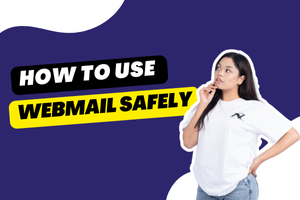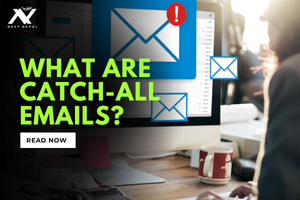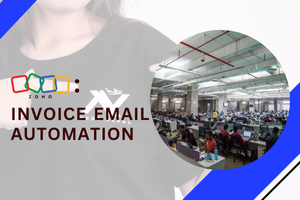Introduction
In today’s hyper-connected world, email is your business lifeline. Whether you’re closing deals, responding to client queries, or coordinating with your team, access to email anytime, anywhere is a must.
That’s where webmail comes in.

Webmail lets you access your inbox from any device with just a browser. But with that flexibility comes risk, especially when you’re logging in from public networks or shared computers. So, how do you enjoy the freedom of webmail without opening the doors to hackers?
This guide covers everything: from what webmail is, how to access it across devices, and most importantly, how to do it securely.
What Is Webmail?
Webmail is a web-based email client that allows users to send, receive, and manage emails through a web browser, without any software installation needed.
You’ve probably used at least one of these:
- Roundcube / Horde / RainLoop – typically accessed via yourdomain.com/webmail in cPanel-based hosting.
- Zoho Mail – login via mail.zoho.com.
- Google Workspace (Gmail) – accessed at mail.google.com.
Webmail vs Desktop Clients
| Webmail | Desktop Email Client |
| Access from any browser/device | Tied to specific device/software |
| No setup required | Needs IMAP/SMTP configuration |
| Login-based (username/password) | Usually cached credentials |
Webmail is built for mobility and convenience, making it ideal for remote work, travel, and multi-device workflows.
Common Ways to Access Webmail

Depending on your email provider or hosting setup, there are several ways to access your emails:
1. Via cPanel Webmail (for Hosting Providers)
- Visit: yourdomain.com/webmail
- Enter your full email address and password
- Choose a client (e.g., Roundcube)
2. Provider Login Pages
- Zoho Mail: mail.zoho.com
- Google Workspace: mail.google.com
3. Mobile/Tablet Access
- Use native email apps or provider apps
- Configure using IMAP (incoming) and SMTP (outgoing) settings
4. Desktop Clients (Optional)
- Outlook, Thunderbird, Apple Mail
- Requires IMAP/SMTP setup: secure, but less portable than webmail
Common Security Risks When Accessing Webmail
While webmail is convenient, it can be a goldmine for attackers if not handled properly.
Here are the major risks:
- Public Wi-Fi attacks: Hackers can sniff traffic on unsecured networks
- Phishing pages: Fake login portals can steal your credentials
- Saved passwords on public computers: Someone else can access your inbox
- Malicious email links: Clicking on suspicious links can compromise your device
Best Practices for Secure Webmail Access
Here’s how to stay safe when checking your email from any device:
Use HTTPS Only
Always check for https:// in the URL. Better yet, bookmark the login page to avoid phishing traps.
Enable Two-Factor Authentication (2FA)
Services like Zoho and Google allow you to enable 2FA, adding an extra layer of protection with OTPs or authentication apps.
Always Log Out After Use
Especially on public or shared devices. Logging out prevents unauthorized access even if you forget to close the tab.
Use Incognito/Private Mode
On public computers, open webmail in incognito mode to avoid storing cookies or login data.
Use a VPN on Public Wi-Fi
VPNs encrypt your internet traffic, protecting you from man-in-the-middle attacks in coffee shops, airports, or hotels.
Stick to Official Apps
If you’re using mobile or desktop clients, use official apps from Zoho, Google, or trusted developers only.
Use Password Managers
Password managers generate and store strong, unique passwords. Never reuse passwords across services.
Set App-Specific Passwords
For clients using IMAP/SMTP, use app-specific passwords instead of your main account password (Zoho and Google support this).
Avoid Clicking on Suspicious Emails
Train yourself and your team to recognize phishing attempts. If in doubt: don’t click.
Device-Specific Security Tips
For Mobile:
- Enable device lock (fingerprint, face ID, or PIN)
- Set a separate passcode for your email app
- Avoid email access via browser if the app is available
For Desktop:
- Keep your browser and OS updated
- Use anti-virus software with email protection
- Log out of email accounts when done
For Tablets:
- Use secure, app-based access
- Avoid browser-based login on shared tablets
- Use VPNs when accessing over untrusted networks
Zoho & Google Workspace: Built-in Security Tools
Zoho Mail
- Enforce 2FA organization-wide
- Session tracking to view device/IP activity
- IP restriction and geofencing
Google Workspace
- Admin console for enforcing security policies
- Alert systems for suspicious logins
- OAuth tokens and secure sign-in options
Bonus: Remote Monitoring via Forwarding or Alerts
While it’s not a security feature per se, you can set up forwarding and filters to keep track of important emails without logging in repeatedly.
- Forward critical alerts to your backup address
- Use filters to prioritize messages
- Enable notification pop-ups in official apps
What to Do If You Suspect Unauthorized Access
If you think someone accessed your email account:
- Change your password immediately
- Revoke all logged-in sessions (Zoho & Google allow this)
- Enable or reset 2FA
- Scan your device for malware
- Inform your IT admin or hosting support (if applicable)
Conclusion
Accessing webmail from anywhere makes life easier, but with that freedom comes responsibility. Whether you’re a freelancer, a growing business, or an enterprise team, following best practices will keep your inbox (and data) secure.
Security isn’t optional. It’s your digital hygiene.
Now go ahead and check your emails, just do it smartly.
Stay connected, without compromising your security.







